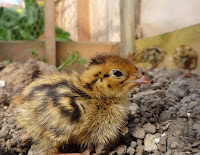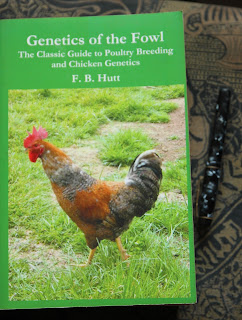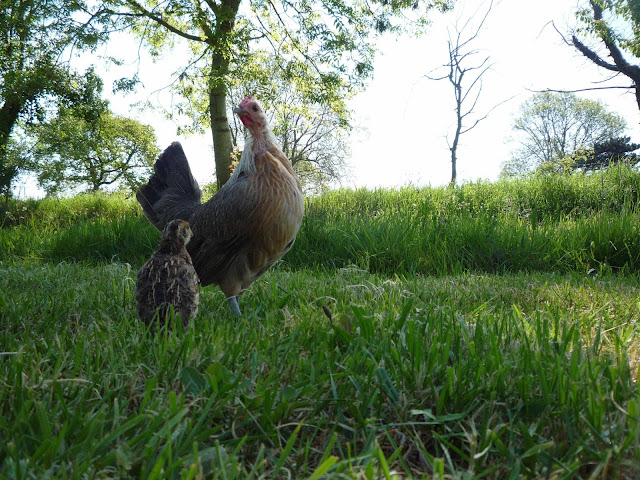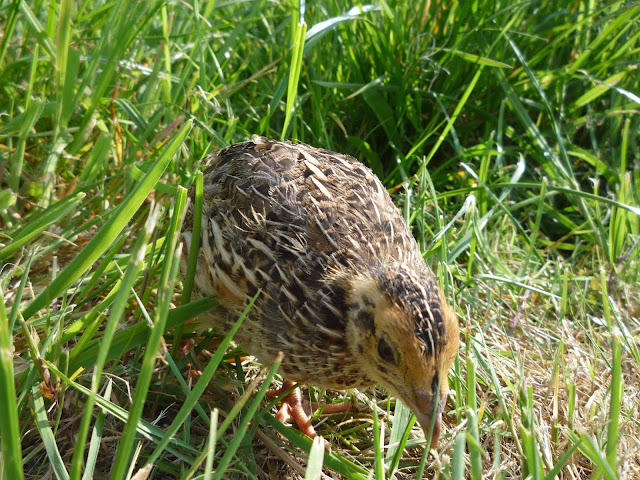In the pages of this site, I write mostly on practical issues and as
'The Holistic Hen', I do always hope that I am looking at the whole
bird. Thus plumage colour is important but just for once I'm going to to
be a frivoler and concentrate on aesthetics. There are so many wonderful words to describe a collection of creatures and probably a 'murder of crows' and its antithesis a 'charm of finches' are my firm favourites. Even so, these are followed swiftly by an 'abominable sight of monks', a 'superfluity of nuns' and a 'busyness of ferrets'. Furthermore, with this week's addition of five, I feel well on the way to announcing that I have achieved a veritable 'drift' of coloured quail.
I thought I'd just showcase some of the colours I have at the moment and in this first part, I'm showing the most popular and common colours of quail, in male and female adult, juvenile and chick form. In the following two articles I'll show the more unusual colours. As some of these are a first for me, I haven't obviously as yet any pictures of chicks - hopefully that will be a part four to this article! It certainly has been quite difficult to identify some of them, so another reason for writing this article is in the hope of clarifying what I believe to be the correct descriptions. If anyone reading this finds I have incorrectly identified my quail, then please do let me know.
Sir John Sebright, friend and fellow explorer with Charles Darwin, is mentioned by the latter in Chapter One of the Origin of the Species:
'That most skilful breeder, Sir John Sebright, used to say, with respect to pigeons, that ‘he would produce any given feather in three years, but it would take him six years to obtain head and beak.’Having dipped into F.B. Hutt's weighty tome and seminal work and in particular, the chapters on feathers and colours, that seems pretty good going to me.
If you want to get into the 'science' of colour then I would recommend this work, though not as light reading! I bought this book some years ago or rather it was bought for me in the US At the time we were living in the UK, where it was out-of-print but now it's available. It's complicated, as with anything concerned with genetics but it's an absorbing and useful reference book. It helped me greatly in explaining how and why incredible, gloriously coloured Frizzles kept turning up in my flock!
Pharaoh or Brown
Below is the film 'The Coulours of Quail - The Pharaoh' and below that is a female (note the spotted breast) in the typical colours we might think of when the words Coturnix japonica or common quail are mentioned. The latter does disservice to this beautiful little creature. I prefer Pharaoh or the poetic French Caille de blés, 'quail of the cornfields', used in France to denote both the japonica and the very similar Coturnix coturnix, aka the wild and migratory European quail. These birds are so named because they concentrate around the French 'bread baskets' of the South West (Aquitaine) and Central region (L'île de France). It is also sadly apposite, that the names of the wild and hybridised brown quail are used synonymously, as before the practice was banned in 2005, vast quantities of brown Coturnix japonica were released yearly by hunting societies. These birds have subsequently interbred with the wild Coturnix and resulted in hybrid chicks, which do not possess migratory genes and often perish in the Winter months. It is a similar story to that of the hundreds of thousands of farmed salmon escaping every year into rivers and seas and in turn breeding with and changing the DNA of the wild fish.Below, here's a juvenile male enjoying a day out free ranging...
and here's a very little Pharaoh coming out into the World....
and another showing how well camouflaged he can be.
This ability of the young Pharaoh, with its 'wild quail' plumage to blend into the background, particularly when out in the open, is an incredible advantage. In addition, you will observe in Part Two of this article, pictures of the golden quail with their spotted and speckled plumage and how well that harmonises them in Nature. On a further note, this is of particular advantage if you wish to free-range your quail, under supervision. Below one of my young Pharaoh free-ranges the meadow under the watchful eye of mother Ardenner bantam and ourselves.
Below, one of my male Pharaohs with his chums about to start work on sifting through and spreading the compost in the greenhouse. It's a plum job as its full of woodlice and probably a few red compost worms, which quail love. As you will observe, my White-laced Chamois Polish brothers are not amused!
The Pharaoh is in my experience a meticulous forager, a great helpmeet in the garden and a candidate for free-range. Its plumage being flecked black and brown, coupled with striped cream markings, significantly help to break-up its outline. To reiterate though, I would always be near enough to intervene in case of predator attack.
So, I hope I've sold you on the idea that there is nothing common about the brown quail, in fact quite the reverse.
I am in the process of making a set of films on the different colours but in the meantime here is a film showing some of them to give you an idea of the beauty of these fabulous quail.
In the next article, I'll look at the glistening golds and shimmering whites and how a Spanish queen's declaration on a 15th century battlefield inspired a quail colour in France.
Thanks for dropping by and do feel free to share experiences or ask for further information in the comment section. If you have enjoyed this piece and found it useful think about sharing it with your family and friends, on social media and also maybe about joining this blog and/or subscribing to my Youtube, Odysee or BitChute Channel or even supporting us on Patreon or
It all helps to keep me going!
All the best,
AN EXAMPLE OF QUAIL-RELATED POSTS
The Colours of Coturnix Quail 2 - Gold
The controversial Golden quail is there just one or more and what's with
the yellow lethal allele? That and more discussed here....read more

Why and how? Getting started.
I had read that for centuries in Japan and China quail eggs had been
used in the treatment of various respiratory diseases and allergies.
Finding no organic eggs on the market, I decided to raise them myself...read more
Choosing the right Mother Hen
Raising quail with a hen is a three way process, there has to be
understanding and adaptability from both mother and chick(s) but there
also has to be...read more
 One of my quail has gone broody and is sitting eggs.
One of my quail has gone broody and is sitting eggs.
So here I am with my design for a secure quail breeding area still in
the workshop and Ginger already sitting and on her 6th day of incubation...read more
 Identification of riboflavin deficiency in purchased quail and hatching eggs
Identification of riboflavin deficiency in purchased quail and hatching eggs
Quail have a high basal metabolic rate and as such their problems with nutrition are dramatically and rapidly revealed...read more
 A comprehensive guide into the history & use of quail eggs in medicine Part 1
A comprehensive guide into the history & use of quail eggs in medicine Part 1
How we cured Andy's hay fever and eczema with a dip into Ancient Egypt and 60's France...read more
 Tips and strategies for raising natural organic quail chicks
Tips and strategies for raising natural organic quail chicks
I hadn't really intended that 'Snow Kitten' should raise quail but she
was broody and I'm always wanting to spread the word on cage-free quail.
In fact it caused quite a stir and eve...read more
Encouraging Pair-bonding, Nesting and Broodiness in Coturnix Quail
I'm sharing the setting up of a safe quail breeding area. Andy and I
created this last year but the broody quail beat us to it...read more
RETURN TO CONTENTS PAGE
© 2018 Sue Cross















